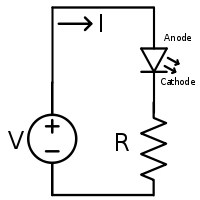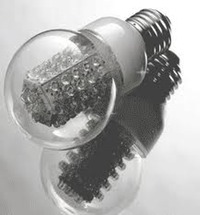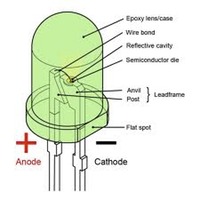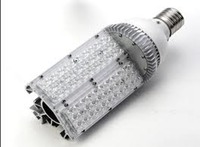How do they Work?
LEDs, or light-emitting diodes, have a few advantanges over incandescent light bulbs, for example, lower energy consumption, they have a longer lifetime, they are smaller, they require more precise current and they are powerful enough to light a whole room. LEDs can emit light from infrared to visible light to ultraviolet light (λ> 760 to λ<400).
LEDs and florescent light bulbs work almost the same way within a circuit with all the components connecting within one circuit. Although, if the voltage supplied to the circuit is equal to the voltage drop then there is no need for the resistor (R). The difference between the two is that instead of the bulb there is an anode and a cathode. Unlike incondescent and florescent bulbs LEDs will only work if their polarity is correct, specifically a positive voltage. If the voltage is reversed and it is a negative voltage it will lead to a breakdown of the bulb and thus break the bulb. The positive voltage needs to go through the anode and then leaves through the cathode. If you take a look at the photo to the right you will see that there are other parts labeled in the photo. The parts inside the bulb work in a very similar fasion to the parts inside a incondescent bulb with a wire band that heats up and emits light as the electrons bounce around.

There is an LED that is called the Geobulb that is so efficient that it emits the equiventent of 60-watts but only uses 7.5 watts. Because LEDs are more efficent we see them all over the place from car break lights to street lights to over head lighting in train cars to emergency lighting signals to Christmas lights. They are the reason we can see we missed a phone call or text message when we look at our cell phones. The reason they are all over is because they can be made in three different sizes: minature 2mm to 8mm and use between 2mA to 20mA, mid-range they are around 100mA and high-power are anywhere between hundreds of mA to an ampere.
There is a downside to having some LEDs: the light that they emit is not bright enough to put into large classrooms, houses and buildings. The reason for this is because some of the light emitted off of the amodes does bounce back into the devise and does not get relased into the room and most people like to have their lamps and ceiling lights to be fairly bright. However, with new technology they are able to make LEDs brighter and more efficient.


